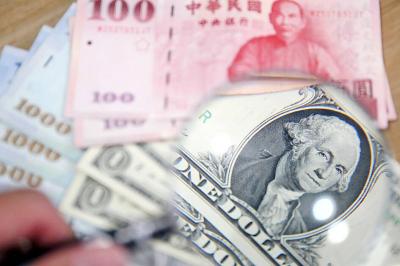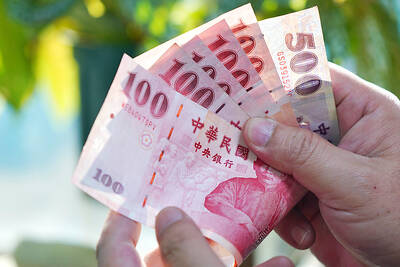The government plans to spend NT$400 billion (US$12 billion) in the next four years building railway lines and expanding ports to improve the nation's public infrastructure, according to the transport ministry's budget.
Spending on new railway lines and mass-transit transit (MRT) networks will cost about NT$211.3 billion over four years, according to a budget paper obtained by reporters. About one-third of the budget, or NT$133.9 billion, will be to build new berths and improve the facilities in five ports in Kaohsiung and Keelung.
Taiwan's economy may expand 5.9 percent this year, according to a government forecast, the fastest annual pace since the 1997 Asian financial crisis. Demand from China, Japan and other markets are helping AU Optronics Corp (
"The spending plan will help stimulate" economic growth, said Tu Jin-lung (杜金龍), who oversees the equivalent of US$6 million for private clients at Taipei-based Grand Cathay Investment Services Co (大華投信), a unit of Grand Cathay Securities Corp (
"Taiwan's steel and cement industries will benefit" as the infrastructure projects boost demand for the building material, Tu said.
An improved transportation infrastructure will enable traveling to be speedier, giving bolstering the movement of foodstuff and tourists, Tu said.
The government has allocated about 5.6 percent of next year's expenditure budget to enhance the nation's transport network. The government is also enhancing ports to cut shipping time, attract freight lines and compete with the ports of Hong Kong, Shanghai and South Korea's Busan.
Taiwan Cement Corp's (
In addition to the new projects, Taiwan is also spending NT$461 billion through government spending and private funds to build a high-speed rail line from the north to the south.
"We're linking the transport systems of major cities" to make commuting easier, Transport Minister Lin Ling-san (
Taiwan's so-called bullet train service, due to begin operating by the end of October next year, can travel at an average speed of 200kph and cut traveling time between Taipei and Kaohsiung by two-thirds to 90 minutes.
The government plans to build a new MRT network in Kaohsiung City, adding to the nation's sole metro system in Taipei. Taiwan Railway, the 117-year-old network that links the nation's north and south will be enhanced to make it into a metro system, Lin said.
Investors will also be invited to take part in a NT$21.6 billion project to build a rail line connecting Taipei with the northeastern resort town of Chiaohsi, Lin said.
Other projects include a highway along the western coast and roads linking CKS International Airport with neighboring towns.
The government will also tap private funds for a NT$12 billion container terminal in Kaohsiung port, with the government spending an additional NT$23.2 billion acquiring land, Lin said.
"Kaohsiung port will be busier in the future," he said. "We can't wait until the port is already too crowded."
The government has been trying to promote Kaohsiung as a trans-shipment port for the region, as its deep waters can accommodate larger ships than most Chinese ports.
"Containers from the China can be placed in larger ships at Kaohsiung," Lin said.
The port is now designated as a ``free port,'' where tax incentives are offered and no visas are needed, he said.
The government has also been calling on the Chinese authorities to talk on lifting the ban on direct transportation links with China to make the Kaohsiung port more attractive to shipping lines.

The US dollar was trading at NT$29.7 at 10am today on the Taipei Foreign Exchange, as the New Taiwan dollar gained NT$1.364 from the previous close last week. The NT dollar continued to rise today, after surging 3.07 percent on Friday. After opening at NT$30.91, the NT dollar gained more than NT$1 in just 15 minutes, briefly passing the NT$30 mark. Before the US Department of the Treasury's semi-annual currency report came out, expectations that the NT dollar would keep rising were already building. The NT dollar on Friday closed at NT$31.064, up by NT$0.953 — a 3.07 percent single-day gain. Today,

‘SHORT TERM’: The local currency would likely remain strong in the near term, driven by anticipated US trade pressure, capital inflows and expectations of a US Fed rate cut The US dollar is expected to fall below NT$30 in the near term, as traders anticipate increased pressure from Washington for Taiwan to allow the New Taiwan dollar to appreciate, Cathay United Bank (國泰世華銀行) chief economist Lin Chi-chao (林啟超) said. Following a sharp drop in the greenback against the NT dollar on Friday, Lin told the Central News Agency that the local currency is likely to remain strong in the short term, driven in part by market psychology surrounding anticipated US policy pressure. On Friday, the US dollar fell NT$0.953, or 3.07 percent, closing at NT$31.064 — its lowest level since Jan.

The New Taiwan dollar and Taiwanese stocks surged on signs that trade tensions between the world’s top two economies might start easing and as US tech earnings boosted the outlook of the nation’s semiconductor exports. The NT dollar strengthened as much as 3.8 percent versus the US dollar to 30.815, the biggest intraday gain since January 2011, closing at NT$31.064. The benchmark TAIEX jumped 2.73 percent to outperform the region’s equity gauges. Outlook for global trade improved after China said it is assessing possible trade talks with the US, providing a boost for the nation’s currency and shares. As the NT dollar

The Financial Supervisory Commission (FSC) yesterday met with some of the nation’s largest insurance companies as a skyrocketing New Taiwan dollar piles pressure on their hundreds of billions of dollars in US bond investments. The commission has asked some life insurance firms, among the biggest Asian holders of US debt, to discuss how the rapidly strengthening NT dollar has impacted their operations, people familiar with the matter said. The meeting took place as the NT dollar jumped as much as 5 percent yesterday, its biggest intraday gain in more than three decades. The local currency surged as exporters rushed to